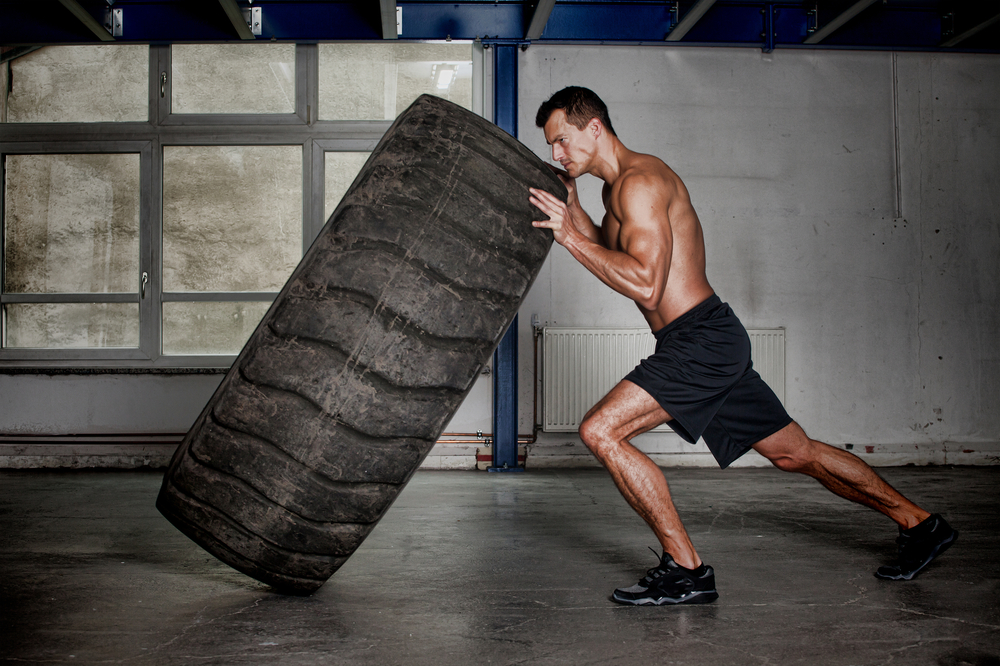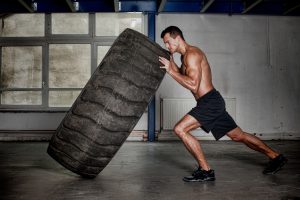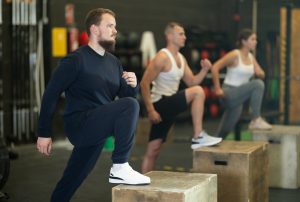Tire workouts are a no-nonsense way to build explosive strength, conditioning, and total-body power using just one piece of equipment.
The three best tire workouts—Shock & Awe, Flip-Hop Crunch, and Flip-Hop Drag—each deliver intense, functional training that will push your limits fast.
Keep reading for a breakdown of how each workout works and how to pick the right one for you.
Why Tire Workouts Deserve a Spot in Your Routine
Tire workouts don’t just look intense—they are intense, and for good reason.
If you’re aiming to train for real-world strength, explosive movement, and next-level conditioning, tire training brings a combination of power and practicality that most gym routines simply don’t match.
What Makes Tire Workouts Different from Standard Gym Exercises
Tire workouts are raw, unpredictable, and highly functional.
Unlike machines or isolated weight exercises that often follow fixed planes of motion, tire exercises demand coordination across multiple muscle groups at once.
You're pushing, pulling, flipping, lifting, jumping—and every movement requires your entire body to engage and stabilize under uneven, shifting loads.
That instability forces you to recruit core, grip, and stabilizer muscles far more than most traditional lifts.
You’re not just working harder—you’re working smarter.
These movements simulate real-world physical challenges that machines simply can't replicate, and that makes them uniquely effective for building strength you can actually use.
Real-World Benefits: Full-Body Strength, Explosive Power, Grip Endurance
One of the biggest upsides of tire workouts is how much they deliver in a single session.
Every tire flip or jump hits your legs, hips, shoulders, and core—and challenges your grip in ways a barbell never will.
You're not isolating muscles here. Instead, you're building integrated strength and power across your entire kinetic chain.
The explosiveness required to drive a tire up and over builds hip extension and posterior chain power—key for sprinting, jumping, or lifting.
Meanwhile, exercises like slams and drags load your grip, forearms, and shoulders while keeping your heart rate elevated.
That means you're improving multiple qualities at once:
- Strength across major muscle groups
- Power output, especially through the hips and upper body
- Muscular and cardiovascular endurance
- Grip strength and core stability
Why They’re Ideal for Strongman, Obstacle Training, and High-Intensity Routines
If you’re training for anything that requires raw strength, power under fatigue, or full-body coordination, tire workouts check every box.
Strongman events often mimic this type of challenge—odd objects, awkward carries, explosive lifts—so these sessions offer direct transfer to performance.
And for obstacle race prep or military-style fitness, it doesn’t get more specific.
Movements like tire flips and drags mimic the demands of crawling, lifting, dragging, or jumping during events.
Plus, the high-intensity format of most tire workouts (especially circuits and AMRAPs) means you're training your mind to handle fatigue and discomfort—crucial for competition or real-life physical demands.
Perfect for Functional Training and Metabolic Conditioning
Tire workouts blur the line between strength and cardio in the best possible way.
You’re not just building muscle—you’re also conditioning your body to work harder, longer, and more efficiently.
This is functional training at its core. The movements aren't controlled or predictable.
They demand stability under load, quick decision-making, and full-body coordination.
That kind of training improves athleticism across the board—whether you're in a sport or just trying to move better, faster, and safer in everyday life.
And because your heart rate stays high throughout most of these workouts, you're getting metabolic conditioning baked in.
That translates to better endurance, faster recovery, and improved overall work capacity—without spending extra time on the treadmill.
Minimal Equipment, Maximum Versatility
All you really need is a tire and some space—and from there, the options are endless.
A single tire can give you dozens of movement combinations depending on how you flip it, jump on it, carry it, or slam it.
And unlike most fitness equipment, a tire forces you to adapt.
It's not symmetrical, it doesn't balance itself, and it won't move unless you move it with purpose and control.
That makes it not only cost-effective but also incredibly adaptable.
Whether you're training at home, in a garage, at a field, or in a gym setting, the tire becomes your all-in-one tool for strength, power, conditioning, and mental grit.
The Gear & Basics: What You Need to Know Before You Flip
Before diving into any of these intense tire workouts, it’s worth taking a moment to get your setup right.
Choosing the proper tire, warming up effectively, and using the right form can mean the difference between solid progress and unnecessary injury.
Here’s what you need to lock down before your first flip.
Tire Types: Choosing the Right Size and Weight
Not all tires are created equal, and starting with the wrong one can either stall your progress or risk injury.
For beginners, it's smart to start light—somewhere between 100 to 200 pounds, often from smaller car or SUV tires.
These still provide plenty of resistance but allow you to learn technique and build strength safely.
More advanced athletes can graduate to medium (250–400 lbs) or heavy tires (400+ lbs), often from trucks or tractors.
Just keep in mind: heavier doesn’t always mean better.
If the tire is too heavy to flip with solid form or makes your transitions awkward, it’s not helping your training.
Your goal is controlled movement, not just surviving the lift.
Also, take into account the height and width.
Tall, wide tires may look intimidating, but can sometimes be easier to grip and flip due to better leverage.
Test a few if you have access, and pick the one that challenges you without compromising control.
Essential Safety Tips: Protect Your Back and Biceps
Tire flips look primal—and they are—but done carelessly, they’re also one of the easiest ways to tweak your back or tear a bicep.
The number one mistake? Pulling with your arms instead of driving with your legs.
Keep your chest against the tire throughout the drive.
This flattens your spine and loads the legs and hips instead of the lower back.
As the tire lifts, transition from an underhand to overhand grip to push it over—don’t yank it up with your arms.
If your arms are doing too much, your form is off and your risk shoots up.
Think of it more like a clean lift than a deadlift.
Generate force from the ground, stay close to the tire, and don’t let your arms take the brunt of the load.
Why Form and Timing Matter More Than Brute Strength
Flipping a tire isn’t just about being strong. It’s about sequencing your movement—legs, hips, then arms—at the right time.
Many people fail their first flip not because they lack power, but because they try to muscle it up instead of driving it with full-body coordination.
Get low, stay tight, and commit to the movement.
A partial effort will waste energy and leave the tire halfway up.
Use explosive leg drive, follow through with your hips, and only bring the arms in to finish the push as the tire starts tipping.
Practice with lighter tires to build muscle memory.
It’s much easier to dial in your form when you're not battling 400+ pounds.
Warm-Up: Prep for Impact and Power
These workouts are high-impact and highly dynamic, so a few shoulder rolls and toe touches won’t cut it.
Focus your warm-up on three areas: joint mobility, posterior chain activation, and nervous system priming.
A good tire session warm-up might include:
- 2–3 minutes of light jogging or jumping rope to elevate heart rate
- Dynamic stretches like leg swings, arm circles, and walking lunges
- Light plyometrics (skater hops, pogo jumps) to prep for explosive movement
- Bodyweight glute bridges or banded walks to wake up your hips and hamstrings
If you skip this step, you're not just risking injury—you’re also leaving performance on the table.
When to Use a Spotter or Lifting Partner
A spotter isn’t mandatory for every tire session, but it can make a big difference when you’re flipping heavy or pushing your limits.
For large, awkward tires—especially those over 400 lbs—a partner can help guide flips, prevent tipping accidents, and assist with stuck transitions without risking your safety.
However, during conditioning-style circuits or AMRAPs where speed matters, having someone constantly step in might break your flow.
In those cases, keep your tire manageable enough to move solo, and save the heavy partner-assisted flips for strength-focused days.
Workout 1 – “Shock & Awe”: Explosive Circuit for Total-Body Conditioning
If you’re after a workout that hits everything—strength, cardio, power, and grit—without spending an hour in the gym, Shock & Awe delivers.
Designed as a non-stop, three-round circuit, this workout uses intense bursts of effort with minimal rest to condition your entire body and build serious athletic capacity fast.
Structure Overview: 3 Rounds, Minimal Rest, High-Intensity Format
The format is straightforward but brutal: three full rounds of five tire-based exercises with about a minute of rest between rounds.
Each movement is performed for reps or time, and the pace is high—this isn’t the kind of session where you ease in slowly.
You go hard, you recover briefly, and then you do it again.
Expect to feel taxed early, especially as your grip and legs begin to fatigue.
That’s part of the design. You’re training your body to recover quickly under pressure and stay explosive when tired—skills that carry over to sports, work, and real-world effort.
Tire Flips: Lower-Body Drive + Upper-Body Control
Tire flips are the centerpiece of this workout and they hit almost everything—quads, hamstrings, glutes, core, shoulders, and grip.
Start from a low squat with your chest pressed into the tire and your hands gripping underneath.
Drive upward through your legs and hips, and as the tire lifts, transition your hands over the top to finish the flip.
Make sure you're not pulling with your arms. Instead, think about pushing the ground away with your legs and using your upper body only to guide and stabilize the finish.
You’re aiming for 8 strong, clean reps each round with a medium to large tire.
Decline Push-Ups: Chest, Shoulders, Core Activation
Feet up on the tire, hands on the ground—this position increases the load on your upper chest and shoulders while forcing your core to stabilize.
The elevation shifts your center of gravity forward, demanding more from your anterior chain with every rep.
Do 10 reps each round, making sure your body stays in a straight line from neck to ankles.
No sagging hips or flared elbows. It’s not just about pressing—it’s about control and alignment under fatigue.
Sledgehammer Slams: Rotational Power and Shoulder Stability
Each round includes 12 total slams—6 per side—onto the tire with a sledgehammer.
This movement teaches rotational force, shoulder control, and explosive power, especially through your obliques and lats.
The key is a clean swing.
Don’t muscle it—rotate through the hips and shoulders, and finish the motion with the hammer striking the tire square.
Reset your stance between sides to avoid twisting unevenly or overloading one direction.
Lateral Tire Jumps: Agility, Explosiveness, Coordination
With 20 reps per round (10 each direction), lateral jumps over the tire challenge coordination, foot speed, and reactive power.
You’re not just bounding—you're landing, stabilizing, and reloading on every takeoff.
These are fast, springy jumps with soft landings.
Keep your chest up and stay light on your feet.
The goal is to stay smooth and controlled even as fatigue sets in.
Farmer Carry: Deadlift Variation with Grip & Endurance Focus
This one’s a twist on the traditional farmer carry.
Start by deadlifting the tire from a kneeling position, then walk forward while holding it.
The move blends brute strength with awkward object control, making your grip, core, and stabilizers do serious work.
Go for 60 seconds of continuous effort.
Don’t worry about covering ground quickly—just hold tight and keep moving with purpose.
Every step under load counts.
How It Pushes Both Aerobic and Anaerobic Systems
What makes Shock & Awe so effective isn’t just the movements—it’s the way they’re structured.
You’ll be tapping into short bursts of explosive energy (anaerobic), but over three rounds with minimal rest, you’re also demanding endurance and recovery efficiency (aerobic).
That dual-system stress makes this workout incredibly effective for burning fat, increasing conditioning, and building resilience.
Your muscles are working, but so is your heart and your lungs—and both will be screaming by Round 3.
Who This Is Great For
If you’re into CrossFit, HIIT, or any kind of performance-based training, this workout fits right in.
It’s also ideal for athletes who need power and conditioning in one session—fighters, field athletes, or anyone looking to stay strong and fast under fatigue.
Even if you're not an athlete, Shock & Awe offers a serious metabolic boost and a way to build whole-body strength without relying on traditional weights.
Just be ready to earn it.
Workout 2 – “Flip‑Hop Crunch”: Strength + Athleticism in One Superset

This workout lives at the intersection of raw strength and fast-twitch athleticism.
Flip‑Hop Crunch is built around supersets that challenge your ability to move powerfully, stay explosive, and maintain form under fatigue—all while pushing your heart rate and loading key muscle groups.
Workout Goal: Combine Brute Strength with Dynamic Movement
This isn’t a grind-it-out strength session where you lift heavy and rest long.
Instead, you’re layering dynamic bodyweight movements with heavy, tire-based power work to build functional strength that translates into real-world movement.
The mix of tire flips, jumps, and loaded bodyweight training keeps your muscles guessing and your lungs working.
You’ll be training your lower body for powerful drive, your upper body for control and endurance, and your core for stability across every movement.
It’s fast, fluid, and demanding—and it will humble even well-conditioned athletes by the third round.
Super-Set Breakdown and Order
The structure here is straightforward but highly effective:
- Complete one superset (two back-to-back exercises)
- Rest 90 seconds
- Repeat for a total of 5 supersets
Each pairing is designed to work similar movement patterns or muscle groups, but in different ways—combining heavy tire flips with athletic plyometrics for a full-spectrum training effect.
Pop Squats: Tire as a Dynamic Plyo Tool
In this movement, the tire becomes a reactive surface.
You’ll start in a low squat beside the tire, then explode up and land flat-footed on top of it, stabilizing through your core and hips.
Step or jump down and repeat for 8 total reps.
This move trains explosive hip drive and foot control—two essentials for athletic movement.
It also loads your quads and glutes under rapid-fire reps, which becomes increasingly challenging as fatigue builds.
Focus on landing softly and staying low to get the most out of it.
Tire Flips + Broad Jumps: Loaded Power + Explosive Leap
Here’s where you stack strength and speed.
You’ll flip the tire, immediately broad jump over it, then flip it back from the other side and repeat.
The combo forces you to move heavy weight with power and then immediately explode off the ground for distance.
Do 6 tire flips, with 6 broad jumps interspersed—one after each flip.
The key is not to rush.
Focus on controlled flips with clean form and full-body engagement, then explode into the jump with arms swinging and hips driving forward.
These paired movements torch the posterior chain, tax the cardiovascular system, and build real-world power fast.
Optional Finisher:
Single-Leg Jumps & Decline Push-Up + Knee Drives
If you’ve still got gas in the tank—or you want to add a finisher to ramp up the challenge—this combo targets unilateral strength, balance, and deep core control.
- Single-Leg Tire Jumps: Jump onto the tire using one leg at a time (10 each leg). This variation improves ankle stability, knee control, and glute engagement.
- Decline Push-Up + Knee Drive: From a decline push-up position (feet on the tire), drive one knee at a time toward your chest at the top of each push-up (12 total reps, alternating sides). It’s a sneaky core burner, and it raises the intensity when your shoulders are already fatigued.
Together, these two movements wrap up the session by hitting smaller stabilizers and core muscles that were supporting the heavy work earlier.
Why This Workout Taxes the Quads, Glutes, Shoulders, and Abs—Fast
Every major muscle group has a job to do here.
The tire flips and pop squats overload your quads and glutes with both force production and deceleration.
Broad jumps and single-leg jumps take that load and push it into the explosive zone, while the decline push-ups and knee drives torch your shoulders and core with time-under-tension and instability.
By Round 3, the burn sets in fast—and not just in your muscles.
Your heart rate stays elevated, your breathing gets shallow, and your grip will likely be fading.
That’s by design. The combo of strength and plyo under fatigue mimics real sport—and real life.
Who Should Try It: Athletes Looking to Build Functional Strength with Cardio
This workout is built for people who need to move powerfully in multiple directions, often under pressure.
Field athletes, martial artists, obstacle racers, and anyone training for explosive output will benefit from this structure.
It also hits the sweet spot for people who want to blend strength work with cardio, without spending an hour running or lifting separately.
If you want to be strong, fast, and conditioned all at once—Flip‑Hop Crunch earns its name.
Workout 3 – “Flip‑Hop Drag”: Functional Chaos for Grip, Grit & Conditioning
This is the workout that tests everything—your power, your patience, your lungs, and especially your grip.
Flip‑Hop Drag isn’t just about how strong you are; it’s about how long you can stay strong while the fatigue builds and your form starts to unravel.
It’s gritty, awkward, and brutally effective—and that’s exactly the point.
AMRAP Format Explained (Why It’s Brutal but Effective)
The format is simple: AMRAP (As Many Rounds As Possible) in 12 minutes.
That means you perform a fixed sequence of movements over and over for 12 straight minutes, trying to complete as many quality rounds as you can without falling apart.
There’s no prescribed rest—just you, the tire, and the clock.
AMRAPs are uniquely effective because they push you to manage your pace while maintaining intensity.
You can’t go full throttle and survive the full 12 minutes, but you can’t coast either.
The constant tension forces your muscles to keep firing and your lungs to stay engaged, all while testing mental grit.
Movement Sequence and Transitions
This workout has four core movements in sequence:
1. Tire Flips (x5)
Start with five heavy tire flips to spike your heart rate and load your posterior chain. The key is to stay low, drive through your legs, and keep your chest against the tire. As fatigue builds across rounds, your technique becomes even more critical—don’t let your form break.
2. Tire Drag Walks (20 meters x5)
Attach a strap or rope to the tire and walk forward, dragging it behind you. This is deceptively taxing. Your quads, glutes, and calves do the work, but your grip and lungs will be the first to fail if you're not ready. Keep your chest up and walk with purpose.
3. Tire Hop-Thrus (x5)
This move requires both timing and coordination. You flip the tire once, then immediately hop into the center, hop out on the other side, and repeat. Do this five times. The hop-thru sequence is excellent for building reactive leg power and dynamic balance—and it adds an unexpected cardio hit.
4. Sledgehammer Slams (x5)
Finish the round with five controlled, hard slams. Rotate fully through the torso, engage your core, and drive the sledge down with intent. Slams not only build shoulder and rotational strength, but they’re also an emotional release—hit that tire like it owes you money.
Then go back to the beginning. Repeat the whole sequence as many times as possible until the 12 minutes are up.
Energy System Breakdown: Strength, Power, and Muscular Endurance
This workout hits every major energy system and pushes them all to the edge.
The tire flips and slams demand short bursts of explosive power, the drags call on grinding strength and stability, and the AMRAP structure itself pulls heavily from muscular and cardiovascular endurance.
You’re not just getting tired—you’re training your body to stay strong while tired.
That’s a different kind of fitness, and it’s what makes this format so brutally effective for anyone who needs to operate under load and under fatigue.
Progressions: Adding Resistance, Time, or Heavier Tires
One of the strengths of this workout is how easily it can be scaled:
- Add weight to the tire for flips or drags by loading it with plates, sandbags, or even chains.
- Use a resistance harness instead of dragging by rope to increase difficulty and emphasize forward drive.
- Extend the AMRAP from 12 minutes to 15 or even 20 for advanced endurance work.
- Shorten rest between movements if you're breaking them up mid-round—this keeps your intensity high.
But don’t add complexity before you’ve mastered the movement sequence. Quality first, then chaos.
Who Benefits Most: Strongman Competitors, OCR Athletes, and Anyone Chasing Next-Level Grit
This workout is tailor-made for athletes who compete in environments that are unpredictable, uncomfortable, and physically demanding.
Strongman competitors will appreciate the heavy lifts and awkward carries.
Obstacle course racers will love the blend of explosiveness, grip work, and continuous movement.
But it’s also for anyone who wants to train not just muscles—but mental toughness.
This isn’t a pretty workout. It’s messy, exhausting, and hard to fake.
You’ll come out of it stronger, leaner, and more resilient.
If Shock & Awe is about power and pace, and Flip-Hop Crunch is about control and speed, then Flip‑Hop Drag is pure grit in motion.
It’s a grind, but it builds the kind of strength that sticks.
How to Choose Your Starting Point & Scale Up Smart
Tire workouts are brutally effective—but only if you start at the right level and build with purpose.
Whether you’re brand new to functional training or coming from a strength or cardio background, picking the right starting point and progressing strategically will make your training more effective, safer, and more sustainable.
How to Pick the Right Workout Based on Your Current Fitness Level
Start by asking yourself two key questions: How comfortable am I with explosive movements? and Can I maintain form under fatigue?
If you're newer to tire training or functional circuits, begin with Flip‑Hop Crunch. It allows for controlled pacing and includes clear rest periods, giving you time to recover and reset between supersets.
If you’re moderately conditioned and looking for an intense, balanced challenge, Shock & Awe is a great middle ground.
It brings the heat but offers predictable structure and rest windows between rounds.
More advanced or highly conditioned athletes ready to push endurance, grip, and mental toughness should dive into Flip‑Hop Drag.
The AMRAP format leaves no room to hide and demands serious work capacity and movement efficiency.
Mixing These Workouts Into an Existing Program
You don’t need to build your whole week around tires—but they fit into almost any training setup if placed strategically.
Here’s how to integrate them:
- Use them as conditioning sessions 1–2 times per week in place of traditional HIIT or cardio.
- Slot them into your off-season as general physical prep (GPP) to rebuild strength and work capacity.
- Incorporate them during deload weeks as lighter but functional alternatives to heavy barbell work.
- Use them for active recovery—just scale down the reps or intensity and focus on movement quality.
What matters is not just doing the workout, but knowing why you’re doing it in the context of your bigger goals.
Beginner Adjustments and Lower-Impact Substitutions
If you’re easing into tire work, don’t be afraid to modify.
Smaller movements, lower reps, and longer rest can go a long way in building confidence and minimizing injury risk.
Try these adjustments:
- Use a lighter or smaller tire for flips and jumps.
- Cut total rounds or time in half—do 1–2 rounds instead of 3, or a 6-minute AMRAP instead of 12.
- Sub in step-ups instead of pop squats, or standard push-ups instead of decline variations.
- Break sets into smaller chunks—e.g., 5 flips instead of 8, with short breaks between.
You’re still getting the movement pattern and building the base—just without overloading your system too early.
How to Track Progress: Time, Reps, Resistance
Progression in tire workouts isn’t just about how heavy the tire is.
There are multiple ways to measure improvement:
- Time per round: How fast can you complete a circuit with clean form?
- Total rounds/reps: In AMRAP formats, track how many rounds you hit and aim to increase gradually.
- Added resistance: Load the tire with weight, or wear a weighted vest during jumps or carries.
- Form quality under fatigue: Video yourself. If your mechanics are still tight in the last round, you’re progressing—even if the numbers stay the same.
Tracking one or more of these markers consistently will help you scale up smart, not recklessly.
Conclusion
Tire workouts are simple in setup but deliver serious results across strength, power, and conditioning.
Whether you choose Shock & Awe, Flip‑Hop Crunch, or Flip‑Hop Drag, each one challenges your body in a different but equally effective way.
Start with the one that fits your level, and commit to the work—it’ll pay off fast.







